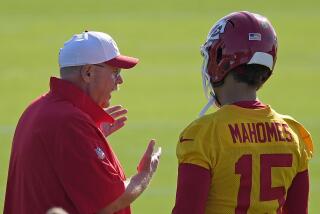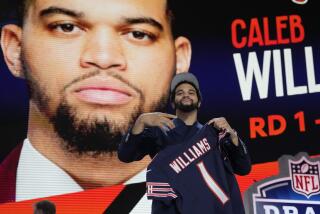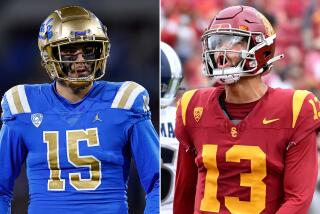As the NFL draft nears, opinions on Cam Newton are all over the map
It’s a good thing the quarterback experts are on edge this week because, frankly, they were getting cocky. The top picks in the last two National Football League drafts were Sam Bradford, to St. Louis, and Matthew Stafford, to Detroit.
That’s pinning tails on two donkeys.
Mark Sanchez, the fifth overall pick in 2009, by the New York Jets, was a fastball right down Broadway. Josh Freeman, selected No. 17 the same year by Tampa Bay, already has passed for 35 touchdowns and 5,306 yards.
In 2008, Matt Ryan went to Atlanta No.3 overall and Baltimore ended up taking no flack for Joe Flacco at No. 18.
Ben Roethlisberger and Aaron Rodgers, first-round choices by Pittsburgh (2004) and Green Bay (2005), have won Super Bowls.
Before that, only four first-round quarterback picks — Terry Bradshaw, Phil Simms, Jim McMahon and Troy Aikman — had won a Lombardi Trophy for the team that drafted them.
However, this week’s annual NFL gathering in New York is back to a mystery meet.
Personnel directors and Pajama U. basement analysts could get their reputations bloodied over this year’s crop of incoming quarterbacks. Washington’s Jake Locker might have gone No. 1 had he entered the draft last year, but he has dropped who knows how far after returning for a senior year in which he led the Huskies to … a Holiday Bowl win.
Off-field concerns have turned Arkansas’ Ryan Mallet into a draft-board yo-yo. What kind of a Ryan is he … Matt or Leaf?
“This is not easy,” said ESPN draft expert Mel Kiper Jr., who touted Locker as the top pick last year, but now projects him as a mid-to-late first-round pick. “This is a very difficult process, trying to figure out who can play and who can’t play.”
No quarterback in recent draft history has been as teasingly tantalizing as Auburn’s Cam Newton, bee-lining toward becoming No. 1 overall and property of the Carolina Panthers despite lingering questions about his NFL readiness.
Newton’s draft status since leading Auburn to the national championship in January seemed to change daily based on what he had for lunch. Yet, he has recently solidified into the consensus can’t-resist choice based on … nobody is sure what.
Newton, 6 feet 6 and 250 pounds, is a physical freak some analysts think can become the next Roethlisberger.
Newton has NFL arm strength sans the throwing-motion quirks that beset run/passers Vince Young and Tim Tebow.
How could one not gravitate toward Newton?
The last quarterback who looked this good coming out of the Southeastern Conference West was …um, JaMarcus Russell.
“I know he isn’t JaMarcus Russell,” said Gil Brandt, the former Dallas Cowboys vice president and now an analyst for NFL.com.
Brandt is staking his professional reputation that Newton isn’t remotely related to the Oakland Raiders’ top choice of 2007.
“I think he’s going to be a successful NFL quarterback,” Brandt said of Newton.
Newton is an near physical clone to Russell, who had just led Louisiana State to a Sugar Bowl win over Notre Dame.
“I can’t wait to get in the black and silver and get to work,” Russell said on draft day.
Then he called in sick for his career — 18 touchdowns and 23 interceptions.
Russell joined the long list of No.1-pick quarterbacks who failed to measure up: Jeff George (1990), Tim Couch (1999), David Carr (2002), Alex Smith (2005). Ryan Leaf was a second-pick bust with San Diego in 1998 but was actually considered 1-A to Peyton Manning.
The bottom line is, despite all the time and money teams invest into drafting, there are no guarantees.
Newton certainly hasn’t enamored everyone.
Nolan Nawrocki, in the Pro Football Weekly draft guide, called him “very disingenuous” with a “fake smile.” Former NFL receiver and NBC analyst Cris Collinsworth gave Newton only a 40% chance of success. “I just have a ton of questions,” Collinsworth recently told Newsday.
Kiper said Newton had huge risk/reward.
“He could be great, he could be a disappointment,” Kiper said on a conference call.
Newton played only 14 games at Auburn, in a simplified, no-huddle system.
Eyebrows were raised when ESPN analyst Jon Gruden asked Newton to recite one of Auburn’s plays, and Newton couldn’t do it.
Gruden didn’t see it as a fatal flaw. “It’s not his fault they don’t huddle,” he said of Auburn’s offense.
But don’t they in the NFL?
One of the toughest tricks in sports is predicting how a running quarterback, from a spread offense, translates from college to the pros.
There are certain things, though, you never know about an NFL quarterback until he plays quarterback in the NFL.
“The big thing is you never know how these guys are going to respond to getting hit,” Gruden said.
Not to mention all the intricate nuances of reading defenses — “Check-off” in the NFL is not a Russian playwright.
Opposing forces are also allowed to draft first-round linebackers.
“They’re paid to stop and demoralize quarterbacks,” Gruden said, “especially young ones.”
There are too many intangibles to make anyone a draft-pick genius.
“I wish there was a way you could find out how good a guy was going to continue to be after he got that big paycheck,” Brandt said.
Front-loading money to a quarterback bust can ruin a franchise, a reason the NFL is pushing for a rookie wage scale.
Huge miscalculations are inevitable.
As the late Bill Walsh said, “Sometimes it’s just a crap shoot.”
Walsh’s legend got rolling in 1979 after he took a third-round pick out of Notre Dame named Joe Montana.
Brilliant move, right, knowing Montana was a perfect fit for the West Coast offense?
Brian Billick, who would later coach the Baltimore Ravens to a Super Bowl title, remembered it differently. He was a lowly San Francisco 49ers’ office staffer at the time Montana was picked. Billick told The Times that Walsh drafted Montana to appease owner Eddie DeBartolo Jr., a Notre Dame graduate.
Billick said Walsh said, “We’d better take the Notre Dame guy because otherwise my butt is out of here.”
Walsh butted out after winning three Super Bowls.
Draft experts in 1998 could not differentiate between Peyton Manning of Tennessee and Ryan Leaf of Washington State.
It turned out one of those quarterbacks was not like the other.
Tom Brady was the 199th pick of the 2000 draft. Kurt Warner, undrafted in 1994 out of Northern Iowa, went from the Arena League to Super Bowl hero.
You can measure a quarterback’s vertical leap, but not always his heart.
So welcome to the crap shoot.
Cincinnati took Akili Smith with the third pick of 1999; Green Bay selected Bart Starr No. 200 (17th round) in 1956.
In 2005, San Francisco spent its No. 1 overall pick on Alex Smith and the Packers picked up Rodgers at No. 24.
Two seventh-round picks that year — Matt Cassel of USC and Ryan Fitzpatrick of Harvard — have panned out better than No. 1.
This year’s Newton mystery is not likely to be solved anytime soon.
Kiper thinks Newton can be a “grand slam” but isn’t ruling out a two-hopper to second base.
“How does he deal with, ‘You’re a bust; you’re no good; you can’t throw the ball accurately; you can’t read a defense?,’ ” Kiper said. “How does he come out of that storm?”
Said Brandt of Newton: “I think I’ve done my due diligence.”
Brandt even assigned his son, Hunter, a student at Auburn, to spy on Newton last fall.
“I told him, ‘I want you to get all the dirt you can on Cam Newton,’ ” Gil Brandt said. “One month later, he says, ‘Well, dad, he doesn’t cut in line, he rides around campus on a motor scooter, goes to class and is friendly to everybody.’ ”
Gil Brandt’s conclusion: “I can’t find anything wrong with the guy.”
That’s always the problem. You never find out until after.
More to Read
Go beyond the scoreboard
Get the latest on L.A.'s teams in the daily Sports Report newsletter.
You may occasionally receive promotional content from the Los Angeles Times.











